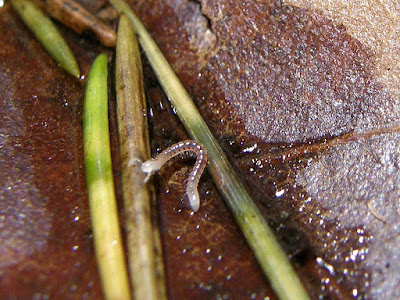A couple of weeks ago, browsing the shelves at
Black Bond Books, looking for new bird or insect guides, I came across
Wildlife & Trees in British Columbia. (Lone Pine, 2006) It looked interesting, and there was a section on birds that looked quite detailed. I bought it, shelved it at home, and forgot it; it's been a hectic two weeks.
I picked it up after supper tonight, and have been reading ever since. (7:00 to 1 AM.) It's that good.
The book was designed with forestry managers in mind, but it's loaded with goodies for birders, tree-watchers, and everybody that ever walks down forest trails. The authors tie together rotting trees, birds, bears, fungi, fire, bats, ants, rivers, beetles ...
They start with the trees;
"What makes a tree a wildlife tree?"
They describe the 8 stages of decay, from a live, healthy tree, to the pile of rotted wood on the forest floor. Each stage has its function in the life of the forest and its residents. Soft wood for insects; food for the birds. Hollow trunks; nest and roosting sites. Bats hang in them, bears den in the larger ones. Protected winter shelters, bare branches for hawk lookouts, loose bark for brown creepers' nests. The tree has barely started its useful life when it dies.
Photos and descriptions show these stages clearly; I'll be looking at trees with clearer eyes from now on.
Woodpecker tree, Watershed Park. Stage 6, I think.
A couple of sections deal with conservation issues for forest managers. I barely skimmed these, although I will definitely go back later and read them.
Next is "Knowing the Trees"; an introduction, followed by a description of 25 of our local trees. (The map covers BC to California.) There's so much info here! My other tree books have species descriptions and maybe a photo or two. In W&T, besides, there's growth patterns, characteristic aging and decay, associations with other trees, and the birds and beasts that depend on them.
"The western red cedar can survive with a higher ratio of decayed wood to living wood than any other B.C. tree species, and ... hollow trunks are relatively common ..."
"Most of the old (Garry) oaks that provide cavities for wildlife today date back to pre-settlement times."
After this, comes "Knowing the Wildlife", and here's where the book really shines for me. 66 species accounts: Birds, Bats ( I had no idea there were so many different species of bats in BC.), Other Mammals. These divided into three categories: Primary Cavity Excavators (chickadees to woodpeckers), Secondary Cavity Users (ducks, owls, bats to bears), Open Nesters (herons, eagles, hawks).
"Some wildlife species depend completely on wildlife trees to complete their life cycles. ... The degree of dependence was a key factor when deciding which species to include in this guide ..."
"Framed" holes. This tree would be stage 2; it still has most of its branches.
The bird section includes nesting sites, roosting habits, wintering holes, distance from feeding grounds, favoured trees and locations in/on the tree, size of holes. And photos; some great shots of owls peeking out of their trees. (As well, in the introduction, there is a section describing how to find active nesting sites for various birds; when, where, how they are hidden.)
I am going to be using this info!
"Great horned owls will cache excess prey. In winter, they thaw frozen meals by incubating them like eggs."
The book ends with Appendices, including a species list for each zone. Our area has 56 wildlife tree-dependent vertebrate species.
Almost perfectly rounded hole in long-dead tree.
"In a society that values youth, beauty and physical perfection above all else, Nature frequently reminds us that ... the old, ugly and deformed can be equally desirable and perhaps more valuable. Wildlife trees are a case in point."
























































